From the faces, the busts, the stomach of an expectant woman (the artist's wife?), a pearl of flesh where the egg of birth lies dormant, to the eyes which release their vision like a flowering seed, to the paintings within paintings, follicles quivering with reflections and colors, as the carpets and curtains quiver at the rhythm of the hands of the letter readers or the lacemaker, paper and wool combined in the same opalescent flow.
This is what Vermeer synthesizes in this example, once by the closed sphere of the Astronomer and again in the opened sphere of the book under the Geographer's compass. But always and everywhere, folds and pleats are continually repeated, sometimes to round out the nail heads which pierce chairs and armchairs, other times to define sleeves and collars of sun and honey. Down to the point of the paint brush which scatters its stellar particles in the quick of the pulp.
Alchemy? Panspermia? Above and beyond the engendered forms, the pearl's translucent light combines with the egg's porous orb. Ab Ovo, said Klee on the bottom of one of his most beautiful paintings. Four centuries apart, two artists found, in the guise of representation, the original Forms waiting for a new dawn.
René Berger, Avril 1996
The Art of Painting - Kunsthistorisches Museum, Vienna, oil on canvas 120 X 100 cm
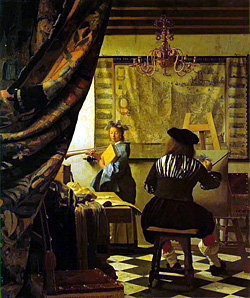
The Painter in his Studio is one of the world's most beautiful paintings. Its format, 51" X 39" (130 X 100 cm), is one of the largest used by Vermeer.Its subject has no subject. The painting represents an interior scene, much like those Vermeer painted throughout his career, with a number of people, two in this case. The ties of silence unite these two people. An interplay of space and light both separates and unites them. Slowly, the emotional relationship which is so typical of the master's work is created.
- What does this painting really represent?
- Who are these characters
- What are the inconographic curiosities
- Do they have any political significance
- What is its story?
After having analyzed this work, let's try to listen to it.Two subjects, two colors. The artist's presence, his model's apparition. Dialogue between the black and white doublet and the airy blue supplied by the material. By these modulations of shadow and light, the artist's doublet is the most erudite demonstration of Vermeer's genius. The yellow-blue match of the book and the young woman's dress influences the chromatic range of the surrounding objects. The young woman, the crowning glory of this painting, along with her phrasing, closely resembles the WOMAN IN BLUE READING A LETTER.Vermeer shows us to what extent a lesson learned is one step in his representation of the absolute.
The painter
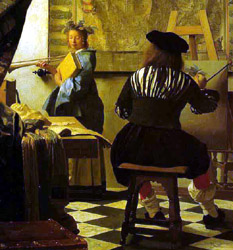
Since the 19th century, most critics have tried to see Vermeer himself as the painter. The painter has done everything to create the most complete ambiguity. There is nothing which allows his identity to be certified. The artist is presented from the back. His palette and his colors cannot be seen. This setting symbolizes the painter's image. Why not Jan Vermeer? Could this be his only self-portrait? How frustrating! Think of Rembrandt who, throughout his life, never ceased representing himself. Several critics have pointed out an oddity. The painter's clothes are not really what was being worn in Holland in 1660 - 1665. These are very old clothes, known as a Burgundian suit, very fashionable in 1530. If this character is Vermeer, why would he set his character 150 years earlier? Strange anachronism.
The woman
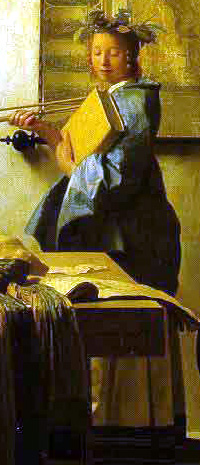
Is this Vermeer's wife Catharina, or his eldest daughter, Bertha? The model's age allows it to be dated. She is very young. If the painter's wife was the model, this would situate it in approximately 1640. In 1640,it would have been improbable for Vermeer to have acquired this mastery of space and light which characterizes his mature works. We know Bertha's features, and they are not those of this young woman...
Iconology
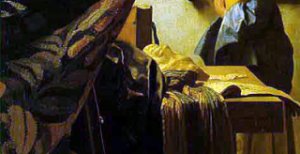

The clothes are strange. Some leaves on her head, a large blue cloth summarily draped over a white apron,the theatrical manner in which she carries a book and trumpet. Who does she represent? Looking through a book on iconology, we discover that the person holding the book in which historyis written, generally Herodotus, as well as the trumpet of Fame is Clio, the Muse of History. The young woman is looking neither at her book, nor the painter, nor the spectator but at the stilllife of objects in front of them. A large, open leather-bound book, a plaster mask with its eyes turned toward the light.It is likely that the book is a musical score, the symbol of Euterpe, Music. The mask could be therepresentation of Thalia, Comedy. The subject's meaning becomes clearer. The painting might represent Vermeer painting Clio, the Muse of history, surrounded by Euterpe's and Thalia's attributes.
Political significance
On the wall, a geographical map by Nicholas Piscator, a great Dutch geographer and chronicler of the 1620s, representing the Netherlands. The typically Dutch, very beautiful brass or bronze candelabra does not contain a single candle. The scene opens up. The curtain is drawn. This is a tapestry from the beginning of the 16th century, crafted in Spain. According to some historians, this strange painting may have some political significance. The painter's clothes, dating from the 1530s, when Holland was under Spanish rule and the sumptuous and colorful tapestry could represent nostalgia for the culture, the taste for the arts and Spanish patronage, led by the Duke of Alba. He was a dreadful politician, but a man who upheld the arts with all his strength and fervor. The famous Thirty Year's War allowed the Dutch to rid themselves of Spanish rule. The society of Great Merchants then came to power. This was a rich and prosperous society, but exquisitely uncultivated and unconcerned with the arts. The candelabra without a candle may be a way of showing this society's lack of glamor. This explanation would help us in understanding artists' uneasiness during this period. In Rembrandt's, Franz Hals' or Fabritius' biographies, we can find Dutch society's obtuse and opaque incomprehension of the audacity of this new style of painting. In the preceding period, the most avant-garde painters elicited the interest of the Spanish patrons. This bitter climate might have been discreetly symbolized by Vermeer in the ARTIST IN HIS STUDIO.History
The painting's history. After Vermeer's death, the painting belonged to his widow, who gave it to her mother as the guarantee of a debt contracted six months earlier. Both died soon after Jan Vermeer. In 1696, THE ARTIST IN HIS STUDIO was sold at auction at Amsterdam's greatest merchant of the period. On that morning, 134 Dutch paintings were sold, including the 21 Vermeers. THE ARTIST IN HIS STUDIO bore number 3. It was sold for 45 florins. THE MAIDSERVANT POURING MILK sold for 175 florins. The painting had not been understood. In the 18th century, it was part of Baron Fr. Witten's collections; he was the Austrian ambassador in Brussels, then in Paris and Berlin. This ambassador was peculiar in that he never left his paintings behind. The work followed him. In 1813, it was sold by his descendants to Count Czernine in Vienna for 50 Austrian guilders. Keeping a painting like this at home was dangerous. Czernine's descendants deposited it in Vienna's Kunsthistorisches Museum. Adolf Hitler eyed the museum greedily. In 1942, the painting disappeared. It was thought that it was part of Goebbels' private collections. Fortunately, it was returned to the Kunsthistorisches Museum in 1946, where we can admire it today. A leading painting of Western art, it is curious to note that it has never been vandalized, stolen or taken for ransom. Does Vermeer's peace guarantee the painting's?The Procuress - 1656 (143 x 130 cm.) - Staatliche Kunstsammlungen, Gemäldegalerie, Dresden
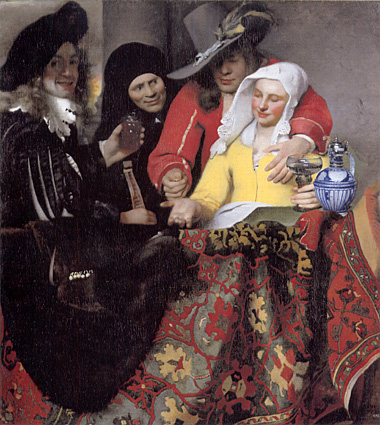
This painting is the first known Vermeer. A large format work 56.3 X 51.2" (143 X 130 cm).The subject, the decor and the cultural climate are perfectly exemplary of the Caravaggio school, in the tradition of raconteurs of ribald stories, prodigal sons and cheaters.One can see a young woman, whose firm curves are being groped by the putative client under the attentive eye of the assistant procuress. It Is obvious that what could be and is very often vulgar when rendered by certain painters of the Caravaggio schoool, is transcended here. All the emphasis is put on beauty, the quality of the admirable tapestry, the balustrade and the perfect contrast of the yellow with the work's overall reddish-brown hue. A painting with promise. Vermeer had not yet been born.
A Maid Asleep
Faithful to the esthetics of the previous painting, Vermeer shows a large table, a pretext for painting a carpet and a young woman, a pretext for rendering the crimson of the skin and a decor reduced to essentials of some vertical and horizontal lines. A painting without a subject, it nevertheless can make you dream an entire lifetime. That is the miracle of Vermeer. Nothing happens and epic tales are born. In the carpet's velvety nap and shimmer, the beauty of the still life and the stoneware's belly, the admirable fruit dish, one begins to feel what he will search for. One can also notice great progress in the level of his trade, in his painting. Vermeer really deserves to be called an impressionist: nobody better succeeded in rendering this shimmering of light on an object through the use of paint. A superb painting, but still not quite Vermeer.
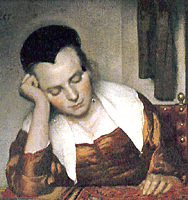
A Maid Asleep - 1656-57 - 87.6 x 76.5 cm - The Metropolitan Museum of Art, New York
Girl Reading a Letter at an Open Window
An extremely simple space. Horizontals and verticals are used as a background for the supple lines of the young model reading her letter.Vermeer's fundamental problem is revealed here: the positioning in space, in time and the color of his model or models, in an always uncompromising, given perspective.
What painter other than Vermeer would take the trouble to reflect the young woman's face in the glass pane and to show it with the mosaic effect due to the multiple panes?
In this dialogue with oneself, something recalls the poetry of the masterpieces which we shall discover. 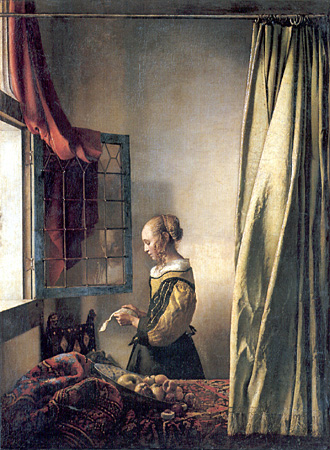
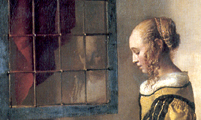
Girl Reading a Letter at an Open Window- c. 1657-1659 - 83 x 64.5 cm.- Staatliche Kunstsammlungen, Gemäldegalerie, Dresden 
View of Delft - A guided art history tour through this painting
One of the only signed and dated paintings.
1646: Vermeer's genius bursts forth in the VIEW OF DELFT - it's amazing.It is one of the only paintings in the history of Western art showing us a privileged moment of vision lasting a fraction of a second.
Normally, a landscape is shown bathed in light or drowned in darkness, for eternity. Vermeer shows Delft in shadows.Suddenly, for the time of a single breath, a ray of sunlight lights, illuminates the city. One holds one's breath. The sun will disappear. This is the impression of an ephemeral fleeting moment, painted with such serenity and classicism that this second seems to have been etched into eternity.
Proust said: "From the moment I saw the View of Delft at The Hague Museum, I knew that I had seen the world's most beautiful painting".
Never a solid color. A great number of small strokes create the illusion of solid colors. A dialogue between juxtaposed flakes gives all his paintings a sparkling effect. The word pointillism is called for. All is accomplished by allusion, by stipple. This is how the mirage aspect was created which can be seen in all his work, as though reality were slipping away, to be transcended by the vision.
The density of the colors is so powerful that no reproduction can really show it.
The lapis lazuli of some of the roofs, its decline into the grey reflections, which is then glorified by the interaction of the clouds, can hardly be noticed. The interplay of the sunlight is so subtle that is only revealed in the original.
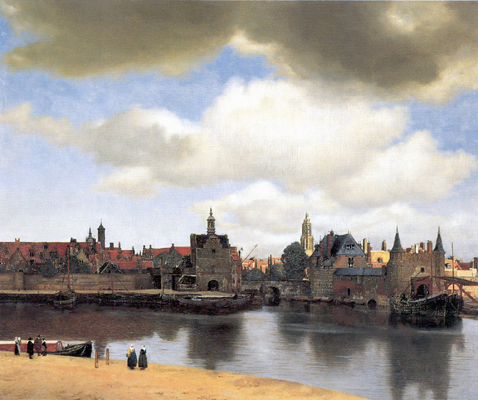
View of Delft - 1660-1661 - 98.5 x 117.5 cm. - The Mauritshuis, The Hague
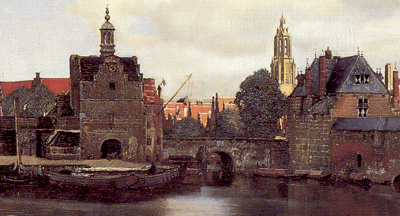
...Bergotte died in the following circumstances: due to a slight attack of uremia, rest had been prescribed for him. But a critic had written that in the View of Delft (on loan from The Hague museum for a Dutch exhibition), a painting which he adored and thought he knew very well, a small section of yellow wall (which he did not remember) was so well painted that, if it were considered alone, like a precious Chinese work of art, its beauty was sufficient unto itself.So Bergotte ate a few potatoes, went out and entered the exhibition. As soon as he started climbing the stairs, he was overcome with dizziness. He passed several paintings and had the impression of dryness and the uselessness of such artificial art, which could not be compared to the drafts and the sun of a Venetian palazzo or a simple house by the sea shore. Finally, he was in front of the Vermeer, which he remembered as more striking, different than anything else he knew, but in which, thanks to the critic's article, he noticed, for the first time, the small characters in blue, that the sand was pink and, finally, the precious material of the very small section of yellow wall. He was getting dizzier; he fixed his gaze on the precious little section of wall, like a child eying a yellow butterfly he means to catch. This is how I should have written, he said. My last books were too dry; I should have applied several layers of color, made my language more precious in and of itself, like this small section of yellow wall. He was fully aware, however, of the severity of his dizziness. A celestial scale appeared before him, one tray holding his own life, and in the other, the small section of wall, so yellow and well painted. He felt that he had rashly exchanged the former for the latter. "Nevertheless I would not want to be the news item about this exhibition for the evening papers, he thought. He repeated to himself: Little section of yellow wall with an awning, little section of yellow wall. Then he collapsed on a couch.
The Girl with the Wine Glass - 1659-1660
This painting is practically no longer a Vermeer, having been cleaned and restored so many timesover the past centuries. The woman's simple face was completely redone. This painting is, however, an important turning point in Vermeer's work. The two fundamental masses of the white tablecloth and the red dress foreshadow the truly mature.
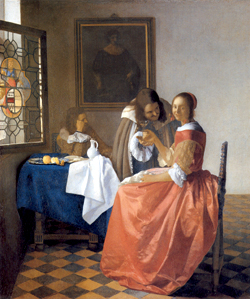
The Girl with the Wine Glass - 1659-1660 - 78 x 67 cm. - Herzog Anton Ulrich-Museum, Brunswick
The Wine Glass
After the View of Delft, Vermeer would no longer paint anything but interior scenes,which will always be the same, in a room, with characters and furniture which arenearly always the same. We will never, however, get the impression of repetition or feelbored. Look at these three paintings:
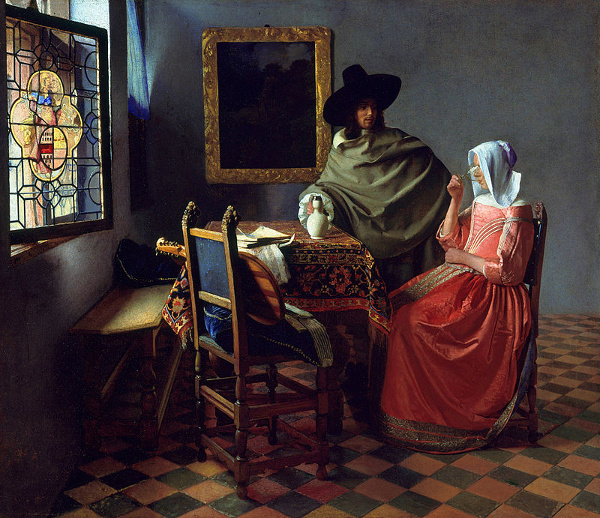
The Wine Glass - 1658-1661 - 65 x 77 cm. - Frick Collection - New-York
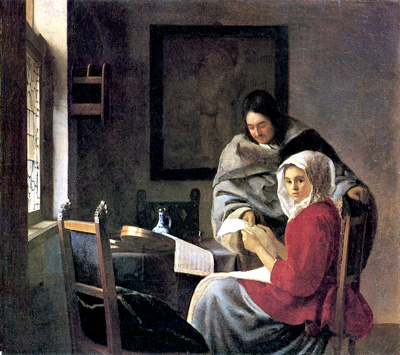
Girl Interrupted at Her Music - ca. 1658–59 - 39.4 x 44.5 cm - Frick Collection, New-York
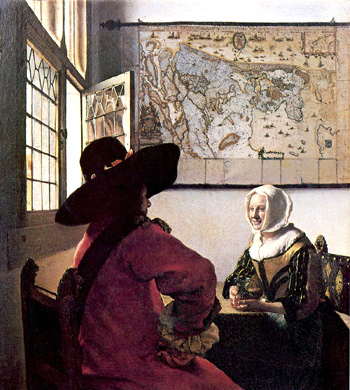
Officer and Laughing Girl - Frick Collection
The concert (stolen 1990)
A significant foreground, as significant as the soldier in the Soldier and Laughing Girl. Inthis case, a table covered with a large tablecloth-curtain.This prominent foreground throws the music setting to the rear and, in so doing, highlights it.
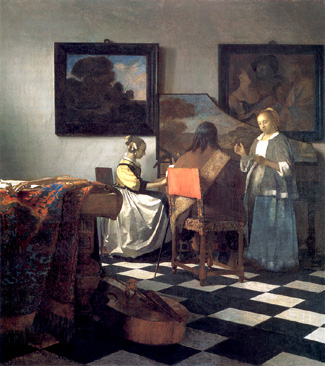
The concert (stolen) - c. 1664-1667 - 72.5 x 64.7 cm. - Isabella Gardner Museum, Boston
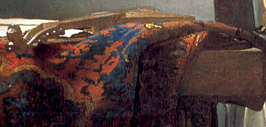
Lady Standing at a Virginal
Beautiful representation of an unmoving young woman, who looks as though she is noodling ratherthan really playing, while a young man contemplates her.The magic of the black and white tiling creates a perspective which is so uncompromising that itbecomes surrealistic.The base viola, positioned in the center of this magnificently horizontal and vertical space, givesthe composition all of its tension and closes with the virginals and the young woman.

Much as Velasquez did in the Maids of Honor, Vermeer placed a mirror over the instrument whichreflects an image which no mirror could: the image of the young woman, slightly plunging andin three-quarter profile. The musical instrument's geometrical severity is balanced by the softness, the silkiness and theflow of the young woman's back, as well as the interplay between the straight and curvedlines of the tiling and the base viola. This is a painting representing only a lady noodling on her instrument while a man listens toher, and yet, because of the accuracy and implacability of this sight line, each painting isa miracle, and this is one of the most beautiful which has been dedicated to music.

Lady Standing at a Virginal - c. 1662-1664 - 73.3 x 64.5 cm. - The Royal Collection
Girl with a Pearl Earring
Nothing less than a spark of eternity. The orient of the pearl in her ear can be found in the look, the smile, even in the gleamingside of the lip and the radiance of her face. This blinding flash, as blinding as the pearl in the shadows, projects something which greatly overshadows the most emblematic and famous portraits in the history of painting.
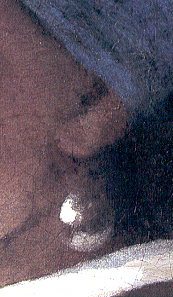
';
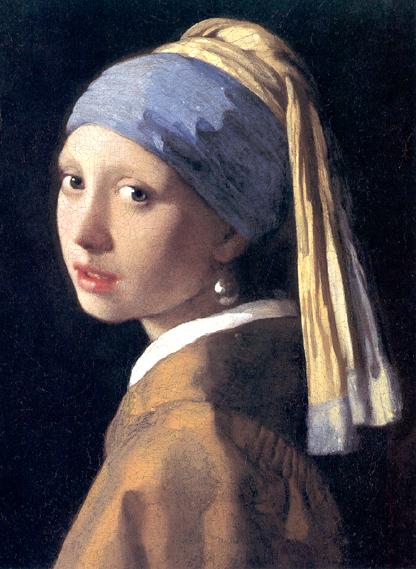
Portrait of a Young Woman
A curious, enigmatic portrait. It is hard to believe that this is a Vermeer.At first glance, it seems distasteful. The young girl is not pretty.But, one is all the more mesmerized the more one looks at it, the more one studies the extraordinarily wide-spacedeyes, the too thin lips and the compensating richness of the blue and white clothing.The Young Girl With Turban provokes an immediate esthetic and sensual feeling of belonging. This cold and icy aspect shows us how Vermeer could work his subject to an infinite degree when he had the right model. The Vermeer miracle works without decor or tricks. Why? The reflection of colors, the marvelously adapted monochrome grey, the allusive nature of the face, whilestill unattractive, is a face of an apparition, sharp and blurred at the same time, done with infinite skill.
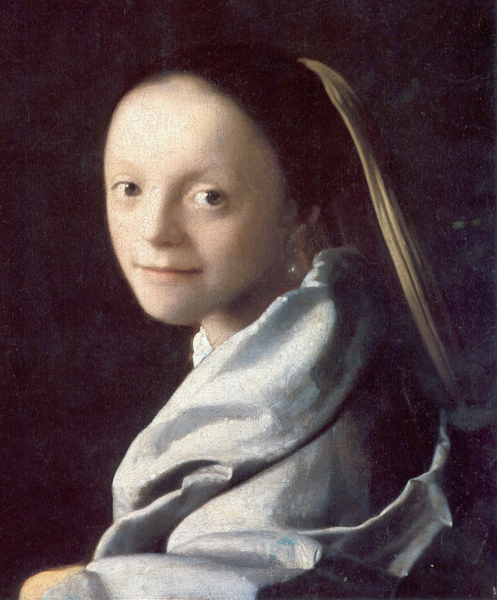
The Milkmaid
In the this painting and THE LACEMAKER, the same attempt: to show, beyond the faces, the beautyof the articles (the bread, the basket, the milk jug's stoneware, the threads, the silk, the shuttle and thelacemaker's cushions). THE MAIDSERVANT POURING MILK is an explosion of color. Each color calls for the other, magnifying the associations.The inside of the maidservant's rolled-up sleeve is grey. It becomes blue because of the presence of the blue apron...Vermeer creates a luminous harmony, warm and fragrant, using the interplay of reflections - from the corsage tothe wickerwork, from the milk to the headdress, from the skirt to the jug and from the apron to the linen.Time elapses at the rhythm of the milk flowing into the bowl. This work underwent serious restoration. Wecannot even imagine its intensity in Vermeer's time.
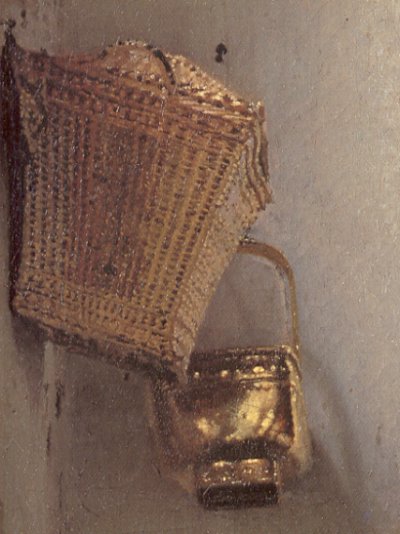

The Milkmaid - c. 1658-1661 - 45.45 x 40.6 cm. - The Rijksmuseum, Amsterdam
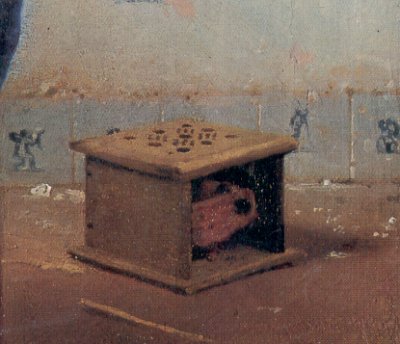
The Lacemaker
In the this painting and MAIDSERVANT POURING MILK , the same attempt: to show, beyond the faces, the beautyof the articles (the bread, the basket, the milk jug's stoneware, the threads, the silk, the shuttle and thelacemaker's cushions). The network of strands of light, indescribably flexible, stretches out. The lacemaker's silken face, fingers andbreath bring her work's threads to life. One cannot imagine things more beautiful than these shuttles and the curious brilliance of the blood red, the blueand the white pointill's which give this painting all its texture and relief. The transparent white collaris an interplay, an overlay of tiny strokes of white, more or less blended into the yellow. Vermeer worked on this painting much as the lacemaker did on her work.Extreme concentration, fanaticism for a perfect creation, perfect control of the use of light. Each brushstroke, like each knitted stitch, creates the network of the lace and the painting. Time elapses at the rhythm of the stitching, serenely and with happiness.
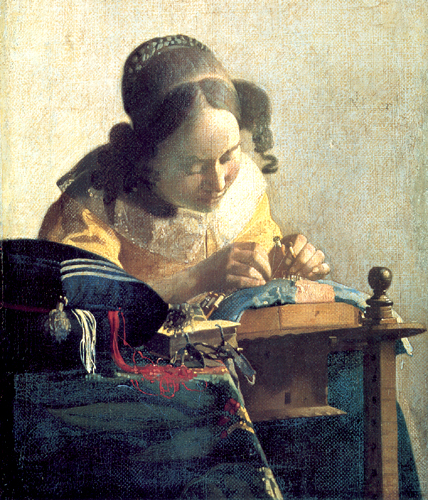
The Lacemaker - c.1669-1671 - 24.5 x 21 cm. - The Louvre, Paris
Young Woman with a Water Pitcher
Symphony in blue and white. Unmistakably, Vermeer's work transposes us into this dream catalepsy, the secret of which is his; wecannot help wondering from where the white is coming and where it is going.?
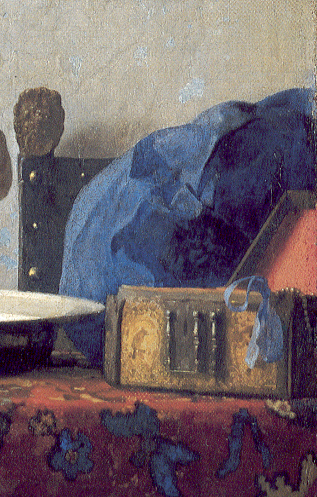
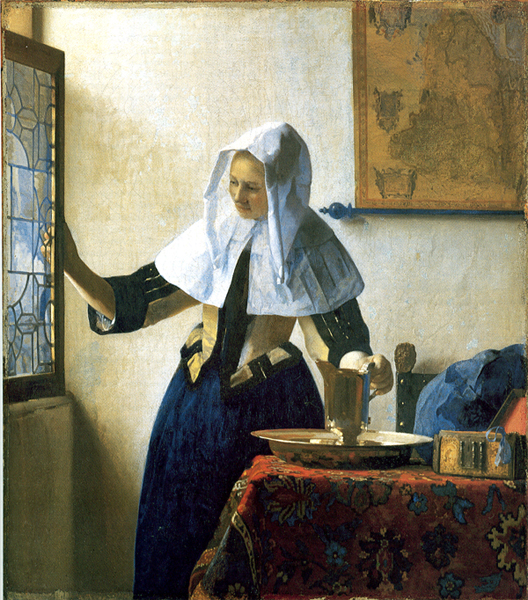
Young Woman with a Water Pitcher - c. 1664-1665 - 45.7 x 40.6 cm - The Metropolitan Museum of Art, New York - Marquand Collection, Gift of Henry G. Marquand
Woman in Blue Reading a Letter
A painting which, rightly, nobody considers to be the height of Vermeer's genius.This is a much more sober work, lacking the effects we saw in WOMAN WEIGHING GOLD and YOUNG WOMAN WITHEWER. The emotional content of WOMAN READING A LETTER bursts out, like the small square of folded white paperagainst the parchment of the large map.
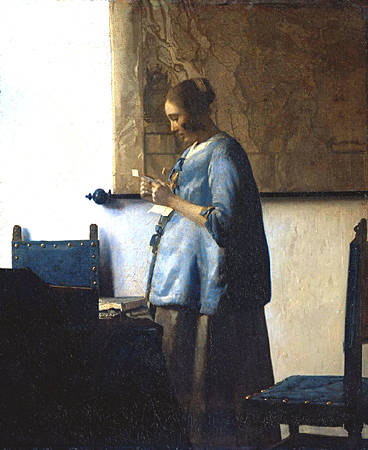
Woman in Blue Reading a Letter - c. 1662-1665 - 46.5 x 38 cm. - The Rijksmuseum
Girl with a Flute
Vermeer has returned to smaller formats: two 7.8 X 7.1" (20 X 18 cm)masterpieces which can be seen in Washington D.C.'s National Gallery and which have some rather special features :
- They have been done on wood panels.
- they only show half of the torso.
- the light comes from the right.

Girl with a Flute (attributed to Vermeer) - c. 1665-1670 - 20 x 17.8 cm. - National Gallery, Washington D.C. - Widner Collection
Mistress and Maid
A chiaro-scuro painting. In the shadows, a very shaded figure, very dark, a creature of the moon, that ofthe servant. She occupies the left part of the painting. Set off against her, a creature of the sun, mottledby the white fur and the yellow bed jacket, sublimated by an earring as in the YOUNG GIRL WITH TURBAN.
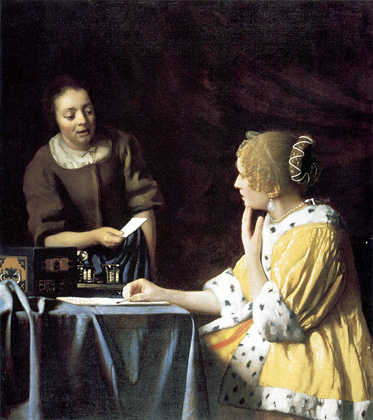
Mistress and Maid - c. 1666-1667 90.2 x 78.7 cm. - The Frick Collection, New York
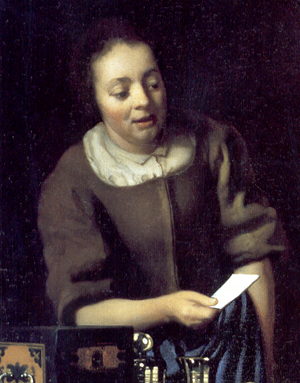
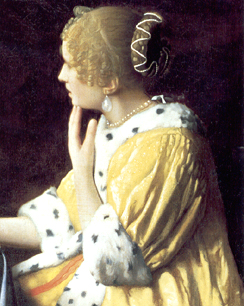
Woman with a Lute
In 1880, this work underwent a difficult restoration.The miracle of modeling which we saw on other instruments and other faces isnot present. The lute is rudimentary. Despite this, ourhearing grows more acute. The sounds created by the young woman fill thespace and seem to echo the light.Lady Standing at a Virginal
This work was painted by Vermeer shortly before his death.Some critics consider that she is too accomplished, too stiff and affected to be compared with the brillianceof the Woman in Blue. On the contrary, in the vertical perfection, in the interplay of the Greek columns ofthe skirt's drape, in this interior's absolute geometrical character, we have a whole made up of emptiness, ofsilence, which is what Vermeer was seeking. Skill and poetry at the peak of his art.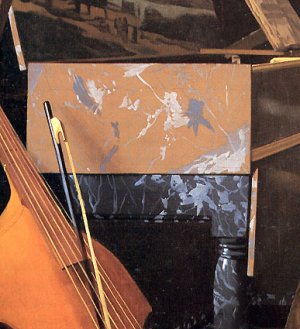
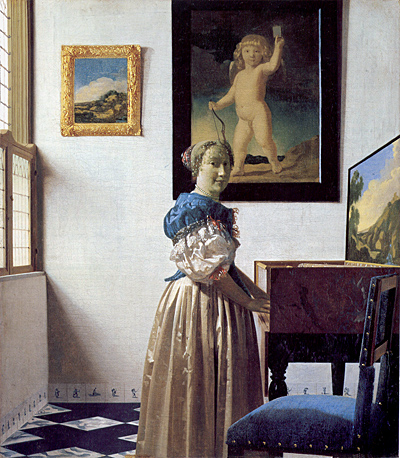
Lady Standing at a Virginal - c. 1670-1673 - 51.7 x 45.2 cm. - National Gallery, London
The Allegory of Faith
Clothed in brilliant white and heavenly blue trimmed with gold, a woman puts her hand on her heart toprofess her faith. Faith dominates, her foot is resting on the world. On an altar-table, the Church's attributes: the Scriptures which bear witness, a chalice, a crucifix and a chasuble. On the tiling, thepattern of which evokes water: an angular stone, Christ crushing a snake, evil, and an apple,original sin. These elements exist in an iconology dated 1613 by Ripa, published in Bologna, and which all painters hadon their bookshelves. This painting is a summary, a pre-death inventory of all the motifs whichcreated the "Vermeer miracle". One last time, we can see the curtain, the chair, the tiling, the tapestry, the model, the painting withinthe painting - a Hanthorst crucifixion - the geometry taken to its extreme and the light, brought togetherby white accents. It is unbelievable to say that all this finally culminates in what is the real symbol of the illusion:hanging over faith is a spidery glass ball, as though in a dream, in which one desperately seeks to findVermeer's reflection, like Van Eyck in the Arnolfini.

The Allegory of Faith - c. 1671- 1674 - (114.3 x 88.9 cm.) - The Metropolitn Museum of Art, New York - Bequest of Micheael Friedsam
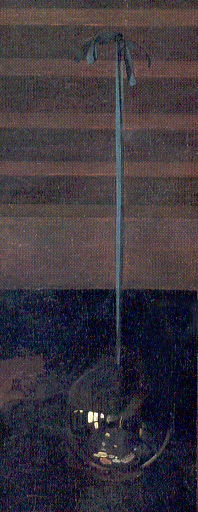
Christ in the house of Martha and Mary

Christ in the house of Martha and Mary - c. 1654-1656 - 160 x 142 cm. - Huile sur toile - National Gallery of Scotland, Edimbourg
Diana and her companions

Diana and her companions 1655 - c. 1653-1656 - 98,5 x 105 cm - The Mauritshuis, The Hague
The little street
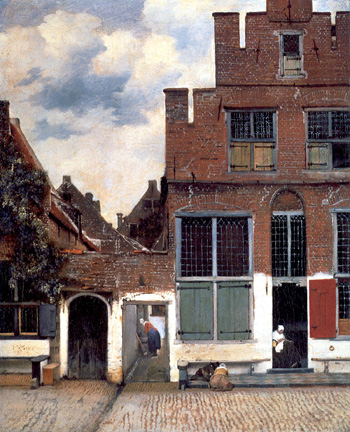
The little street c. 1657-1661 - Huile sur toile - ( 54,3 x 44 cm ) - The Rijksmuseum, Amsterdam
Woman with a Pearl Necklacee
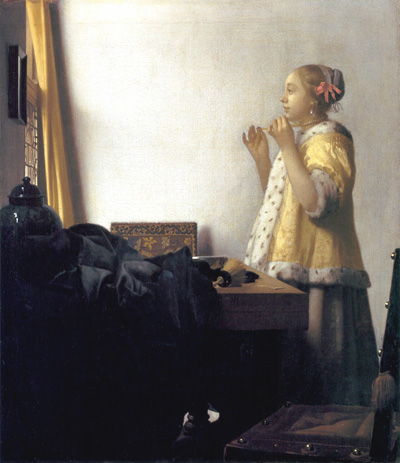
Woman with a Pearl Necklace - c.1662-1665 - 55 x 45 cm. - Staatliche Museen Preußischer Kulturbesitz, Gemäldegalerie, Berlin
The love letter
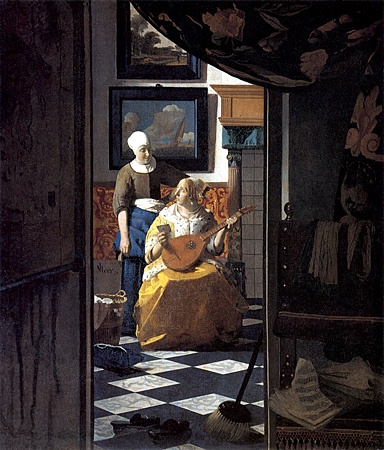
The love letter - c. 1667-1670 - 44 x 38.5.cm - Rijksmuseum, Amsterdam
A lady writing a letter and her servant
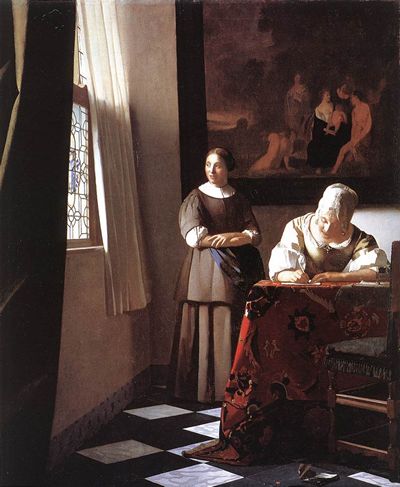
A lady writing a letter and her servant - c. 1670-1671 - 71.1 x 58.4 cm. - National Gallery of Ireland, Dublin
The Astronomer
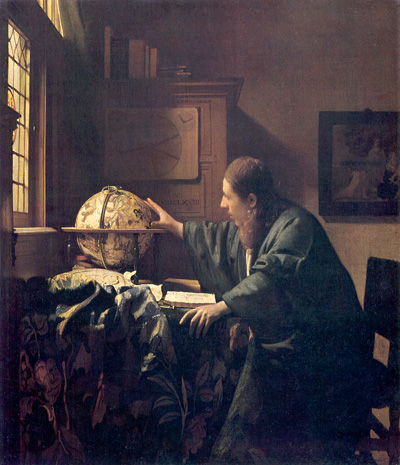
The Astronomer - 1668
50 x 45 cm. - The Louvre, Paris
The Geographer
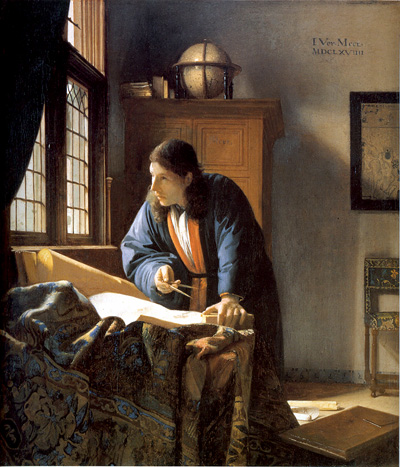
The Astronomer - c.1668-1669
53 x 46.6 cm. - Städelsches Kunstinstitut, Frankfurt am Main
The Guitar Player
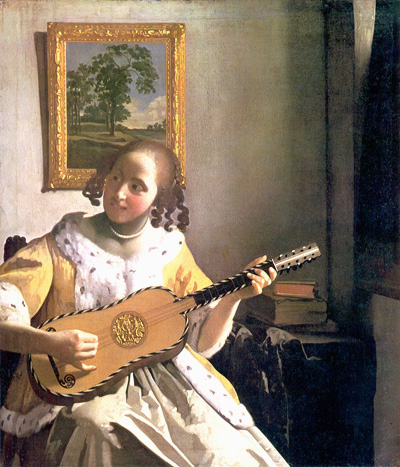
The Guitar Player - c. 1669-72
53 x 46.3 cm. - English Heritage as Trustees of the Iveagh Bequest
Roma
Vermeer's contemporaries: Roma
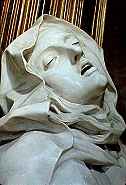
In the years around 1665, the Caravaggio school endured, but the meditation and silence it possessed in Caravaggio's time had become angry and rhetorical with accents presaging the Baroque. In 1665, Caravaggio (1573 - 1610) had been dead for 55 years, but the Caravaggio school flourished with, in particular, Borgianni, Fetti, Rosa, Desiderio and Bernini.
Borgianni was one of the painters who resumed and continued Caravaggio's research into the authenticity of the interpretations of the Scriptures through shadow and light. Using a contrasted chiaro-scuro, a dramatic setting and strong relief, the 1665 Caravaggio school was exacerbated, extremely theatrical and sometimes excessive.
Consider the modesty of Caravaggio's MARY MAGDALENE, completely isolated in a large grey bubble. Here, on the contrary, an eloquent work: a skull, books on the floor, a dog looking elsewhere...
Rosa was one of the great Caravaggio school painters of this generation. His violent, extreme and sarcastic temperament gave his work a romantic and apocalyptic character, much like Caspar David Friedrich. The people occupy only a congruent space of the painting, in a scenery of mountain storms, rocks and vegetation.
The famous pope whose portrait always causes shivers, so keen is his gaze, was one of the great propagators of the baroque. A city planner with cosmic vision, he needed an architect with genius. The pope understood that the greatest genius of the baroque era hid behind Bernini's romantic, extreme and textural sculptures. He drew him into his service and made him his architect and city planner.
The sharp edges, the hatching of space and textures, the romantic, extreme and textural qualities remind one of Borgianni and Salvator Rosa.
Shadow and light are the bearers of spirituality. The more one raises one's eyes, the more one is made aware that Bernini had created an effect of tension and aspiration in the cupola, which brings us to the top, in the shadows, to this oculus, this lantern, deep in which appears the fully lit Holy Ghost. At high noon, the entire cupola comes alive with golden rays, revealing a multitude of putti proclaiming God's greatness.
Madrid
Vermeer's contemporaries: Madrid
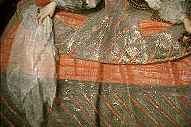
In Spain, the era of Hapsburg domination was at hand, along with a somewhat sugary, celebratory Pietism which perfectly corresponded with the religious aspirations of the Spanish Court and the royal couple (Philip IV and Marie-Anne of Austria, daughter of Emperor Ferdinand II). Zurburan was out of fashion; he died in misery, forgotten by all. Murilli was triumphant, but Velasquez was the official Court painter.
In Zurburan's strict adherence to Caravaggio's principles, one can find the silence, austerity and symbolism which characterize Caravaggio's work.
This youthful work was painted upon his return from Italy. The strict adherence to Caravaggio's principles can be seen in the taste for the symbol that character himself represents, in the composition's rigor and silence. Later, Velasquez would adopt the use of fresh colors, broken up by blacks and whites, to paint the streets and its people.
This last painting was presented to the Duke of Wellington by the King of Spain, along with two Raphaels. It was Velasquez' first masterpiece.
Even more silent, more immobile and more unfathomable than Caravaggio, he nearly equals his contemporary Georges de la Tour.
Velasquez had to serve the Spanish Court. It was out of the question to treat Philip and Marie-Anne "à la Caravaggio". With the esthetics thus being requestioned, he became prodigious in rendering cloth, in placing people and succeeded in turning puppets and models - which was what the king and queen were - into quasi heroic beings.
Velasquez painted the royal couple dozens of times during his life. Here, from all the way in the back of the painting, they are contemplating their daughter, the Infanta Margarita, the blondest, who fascinated the painter and who can be found at all ages, as he painted her throughout his career. What craftsmanship! The representation of cloth flowers on the Infanta's corsage is worthy of Manet...
Still a little girl, wearing an unbelievable dress in blue silk with silver frogs, she shows the seriousness her position in the Court. The willow hoops clicked like castanets when she walked. This painting is incredibly cold, but it was still the one that Marie Anne chose to send to her family in Vienna.
One year later, an Infanta Margarita in a silver and pink dress, tender beyond officialdom. He has succeeded in suggesting the entire cloth's silver lame with liberty, quickness and science. The formal handkerchief, like a shimmering color set on the dress, becomespractically nonexistent. The queen would keep this painting.
A terrifying portrait, dressed as a provincial notary, in black with a white collar, almost Dutch in its austerity. This king who resembles a valet should have been replaced by a valet who resembles a king...
The Duke of Olivares was a minister. Velasquez represents him as a king, for he was Spain's true master.
Paris
Vermeer's contemporaries: Paris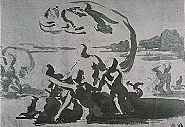
After Rome and Madrid, here is Versailles under Louis XIV: In 1665, Louis XIV was still young, and the enlargement of the small Versailles palace was started, to make it into the immense "cosmos" which it would become over the years.
Poussin was trained in Rome's classical school. "My natural tendency forces me to look for and like well-ordered things, fleeing confusion which I find to be contrary and the enemy, as is the light to dark shadows", 1642. He favored an architectural, constructed and rigorous art. All lines were studied so that the forms, proportions and the perfect balance of curved and straight lines were truly in harmony.
Delft
Vermeer's contemporaries: Delft
"The Golden Century" 1648: the Thirty Years War with Spain ended with the Treaty of Muenster. The United Provinces' 17 provinces were acknowledged to be free and independent. With blinding speed, the economy developed, and Holland prospered, thanks to its industry. It exploited the huge trade dominated by the East Indies Company, founded in 1602, and the West Indies Company, in 1621.The Dutch started to believe in their own identity. As soon as one is free, when one owns the money one earns, one begins to exist. In 1648 - 1650, a genre appears that had previously been ignored, portraiture.